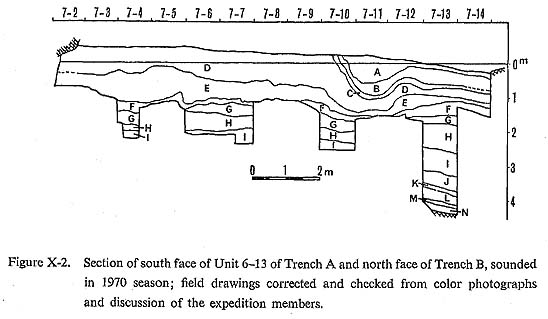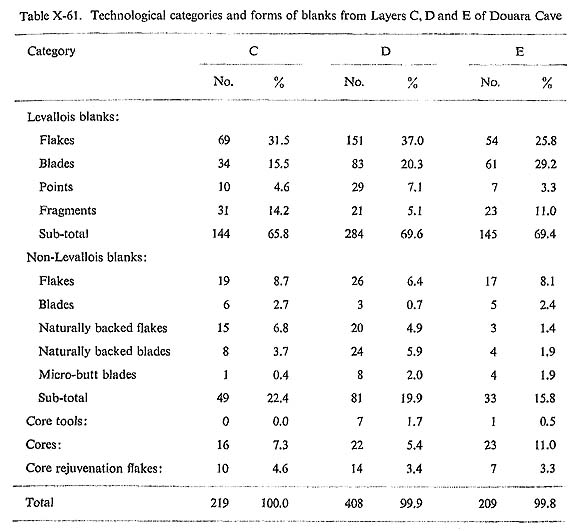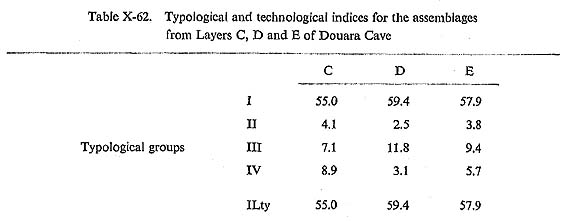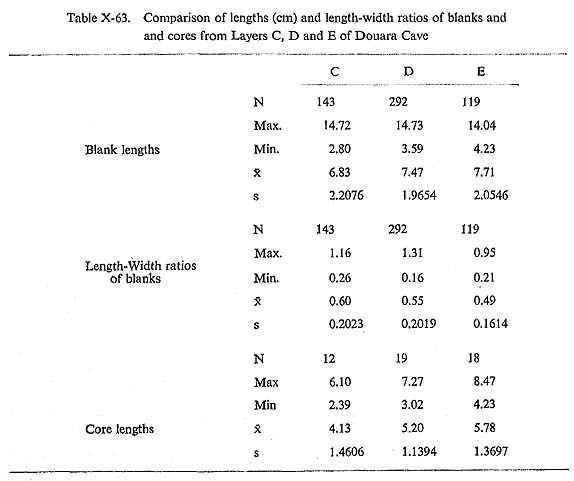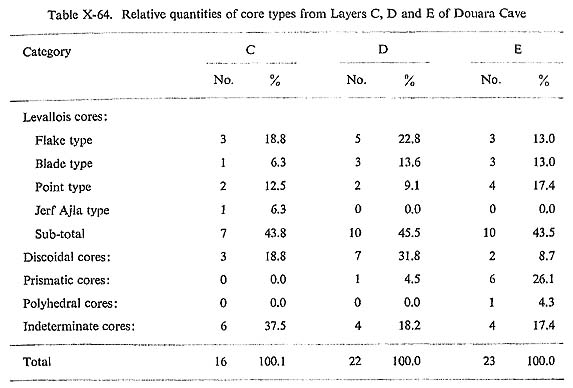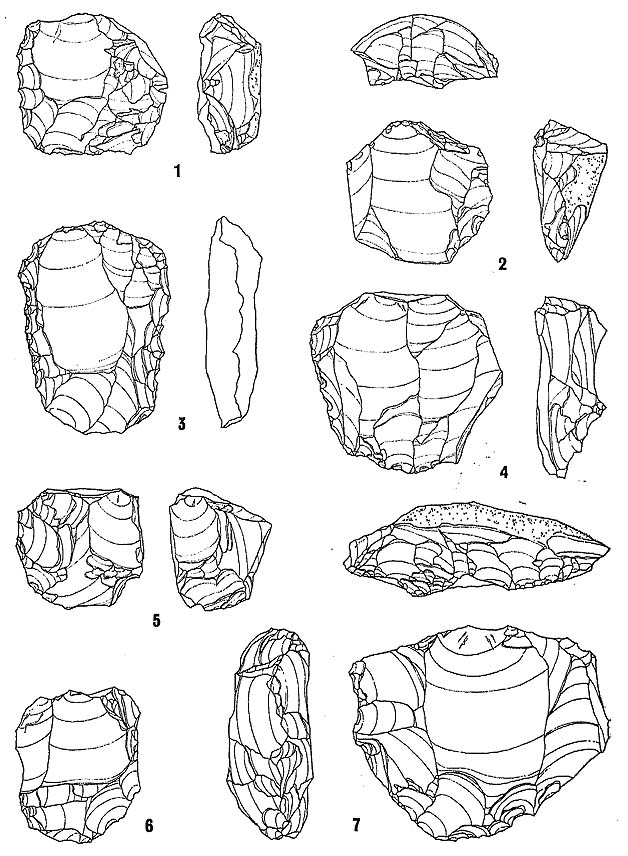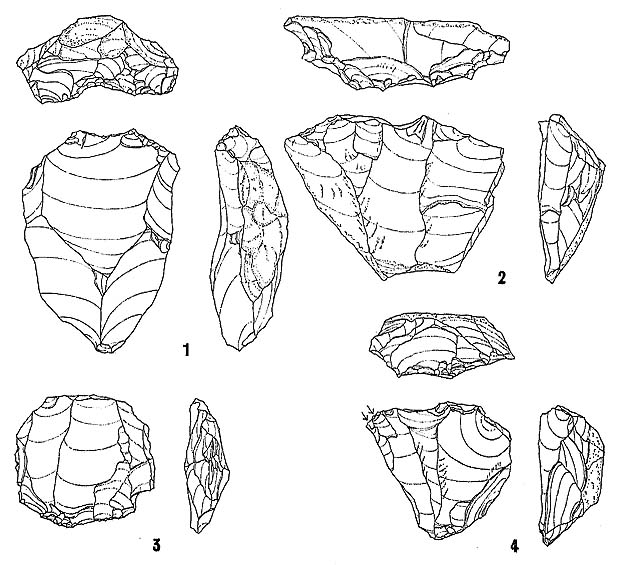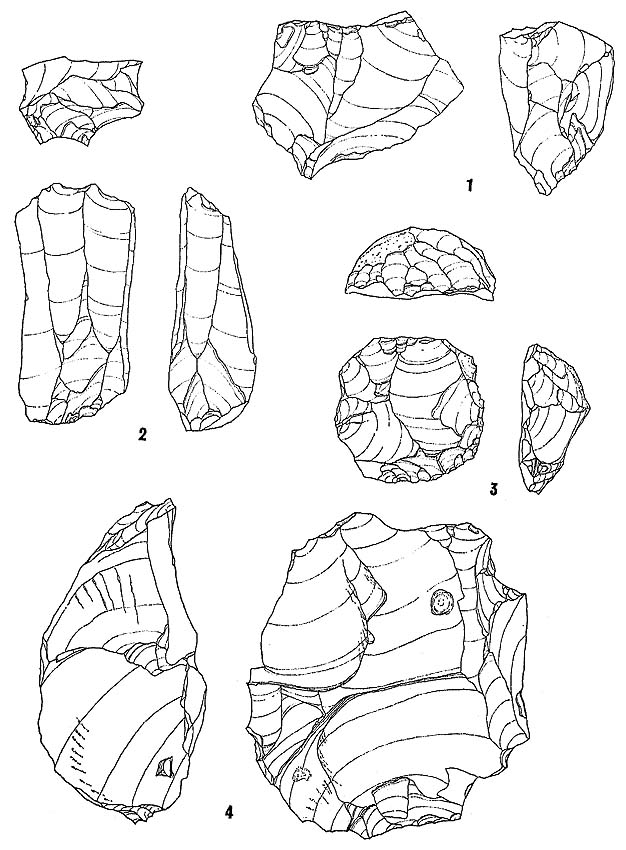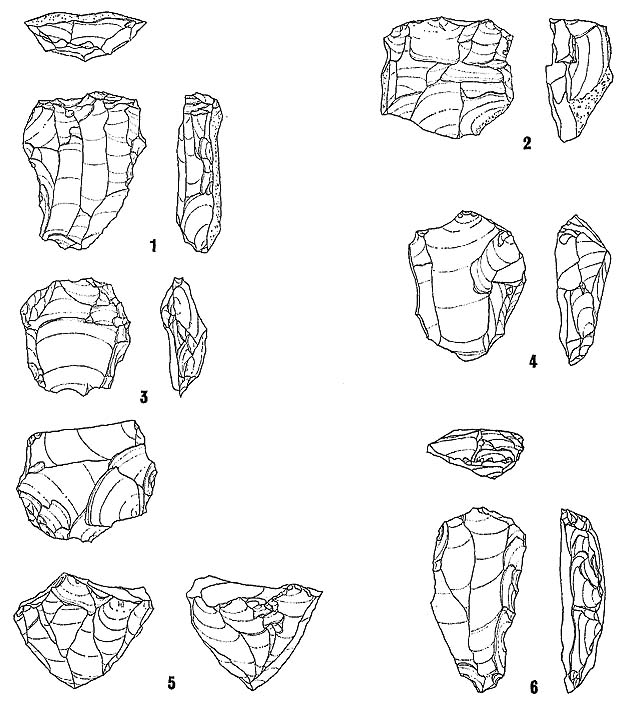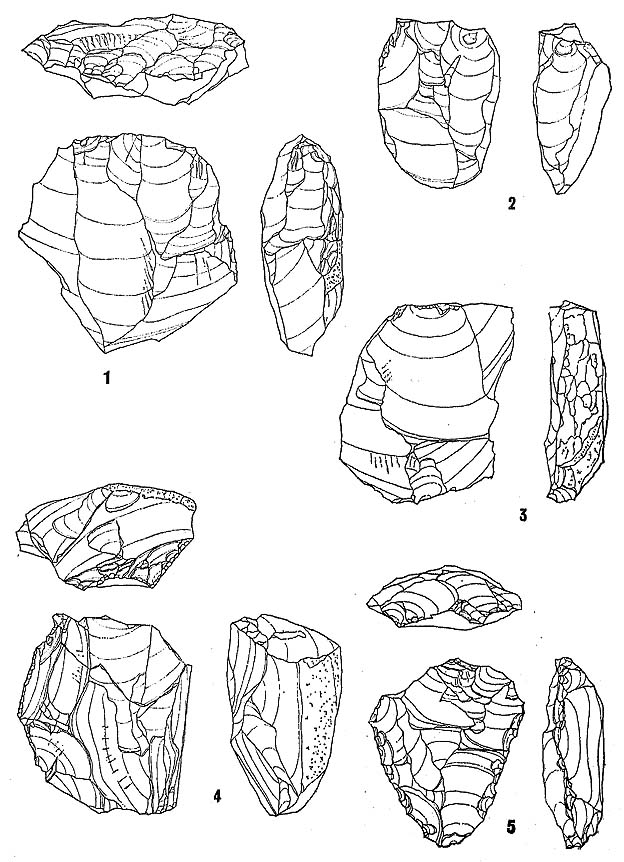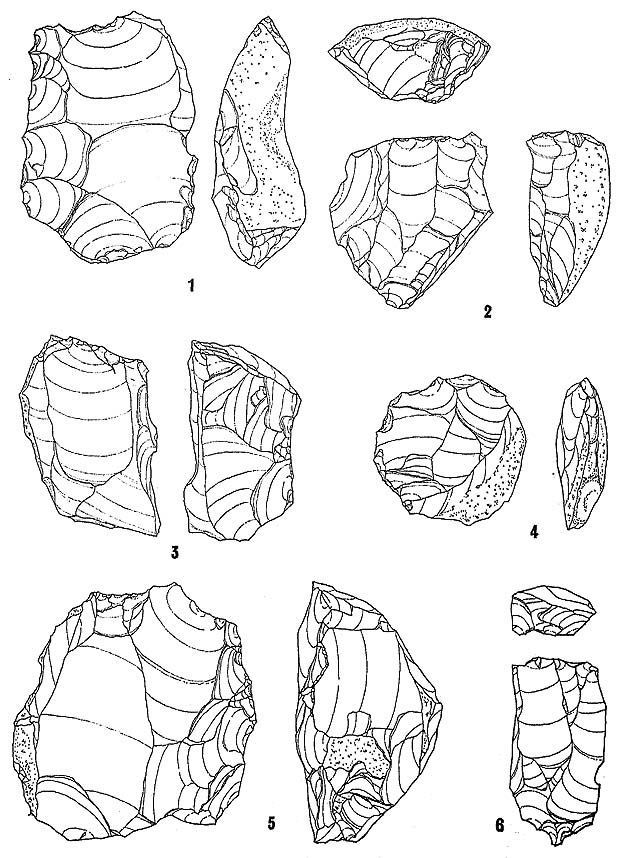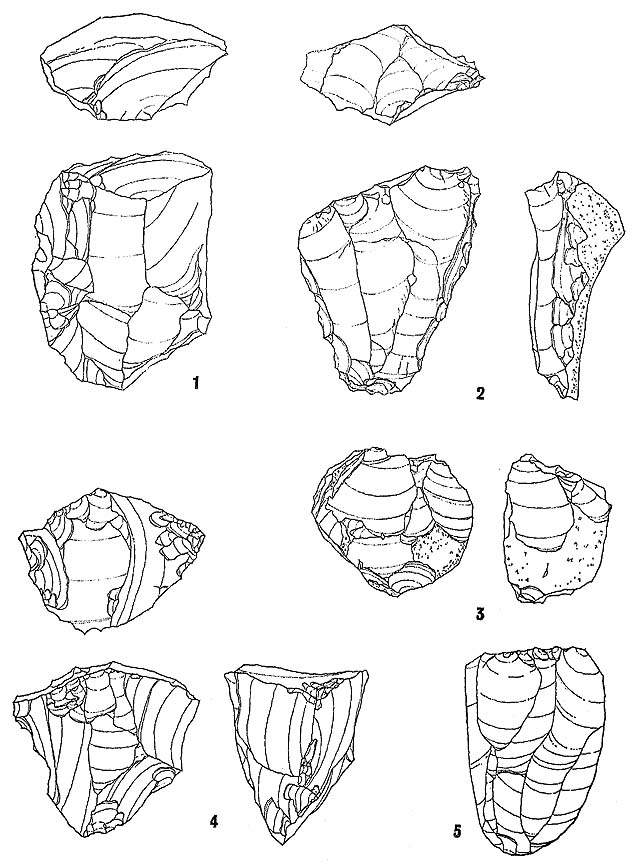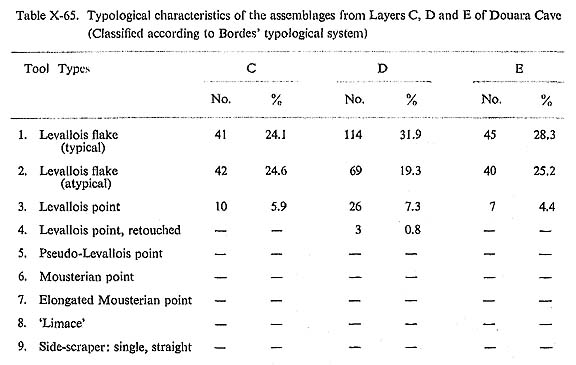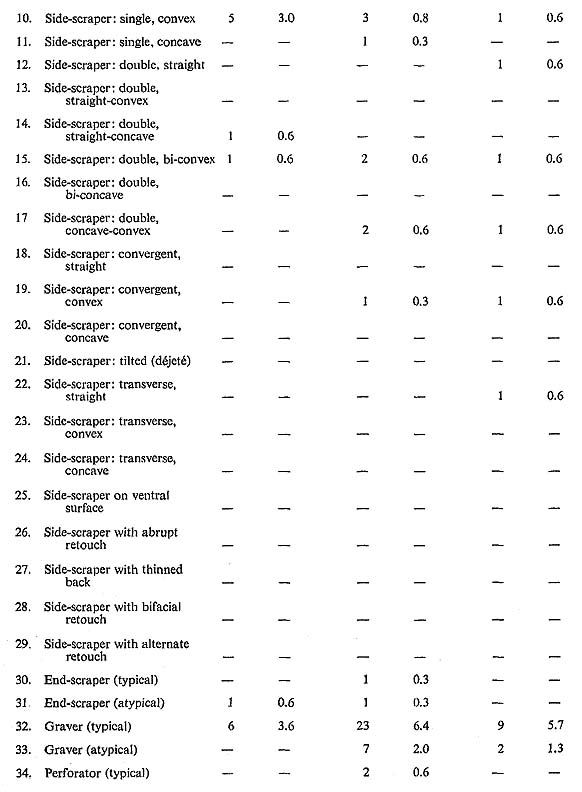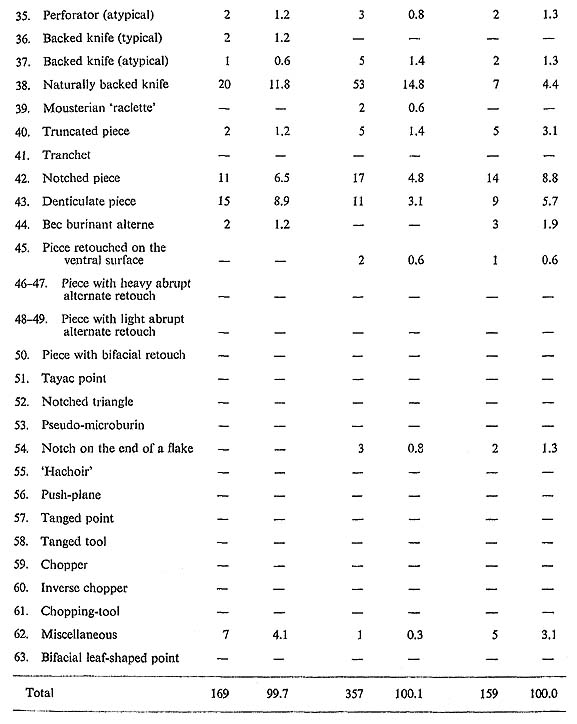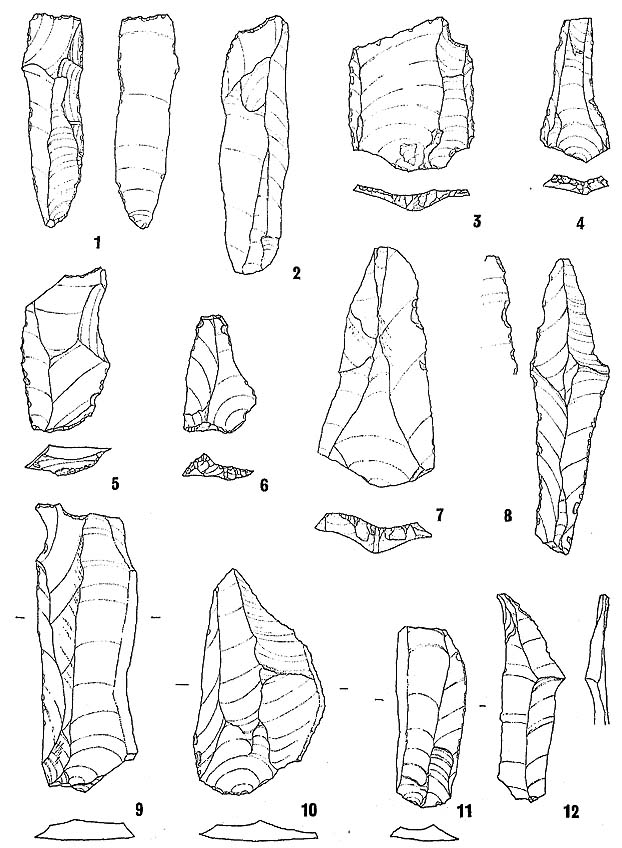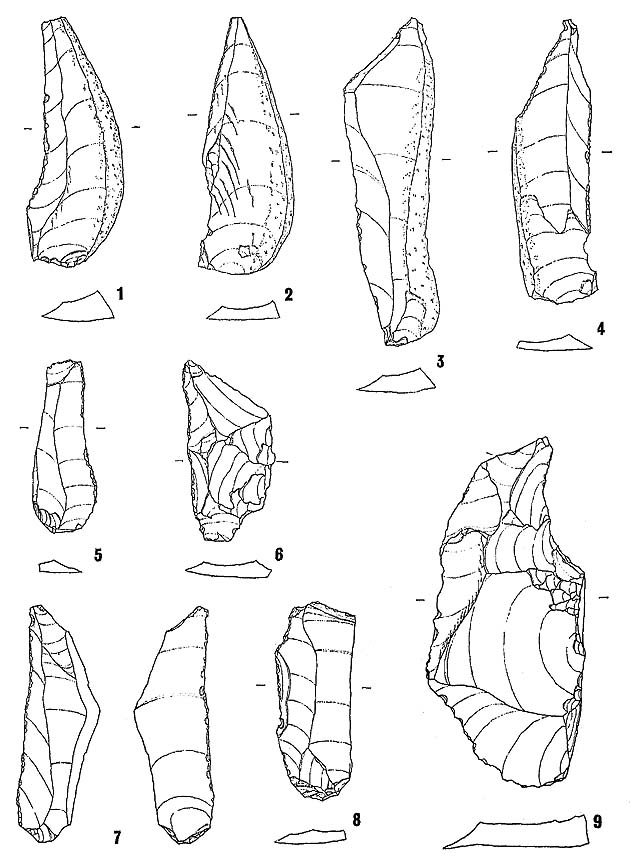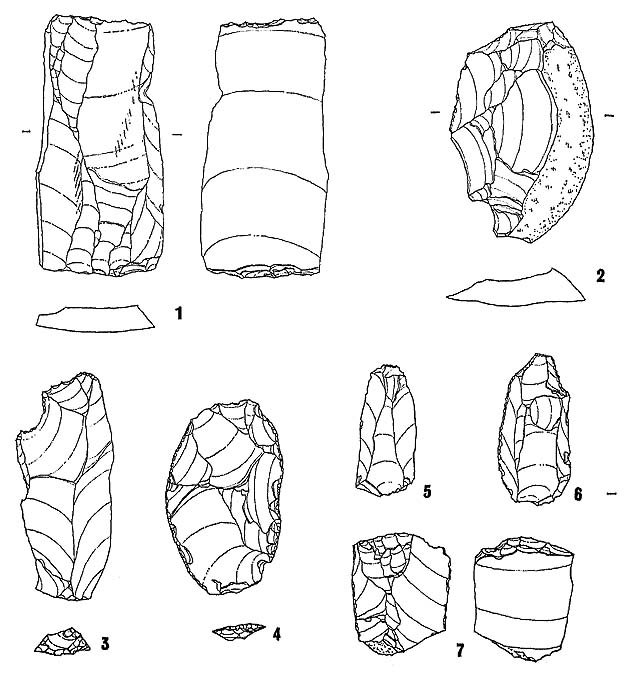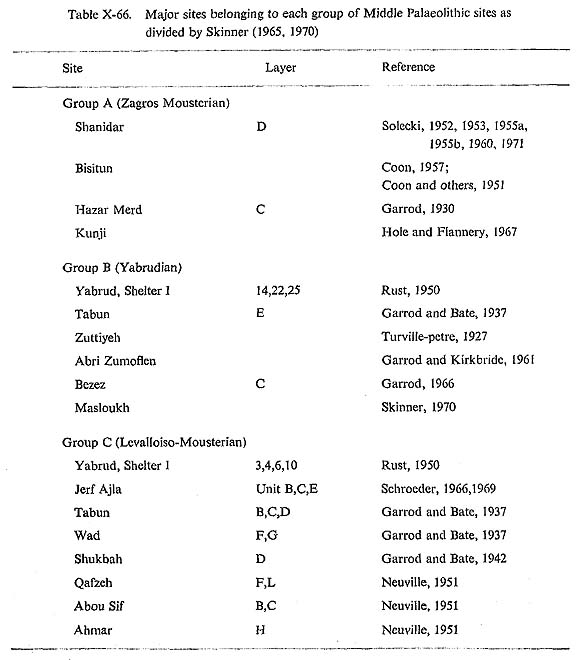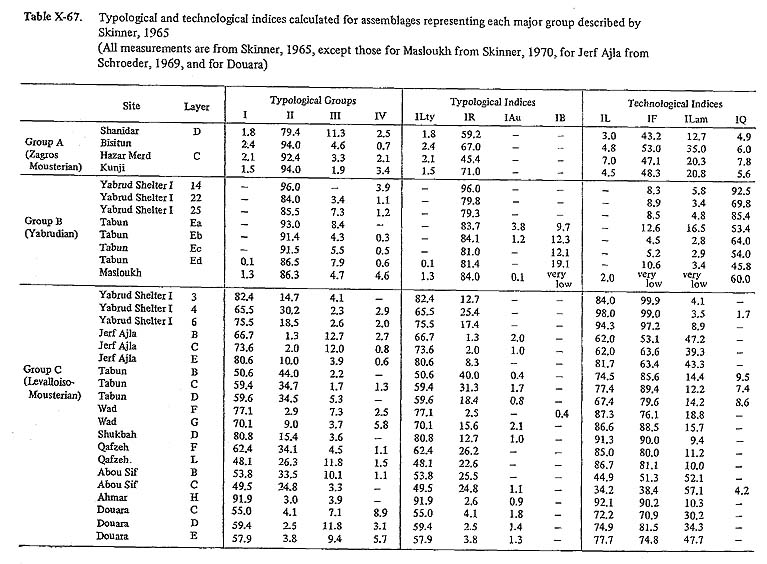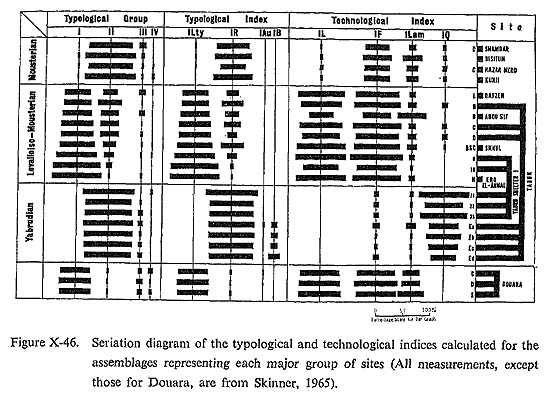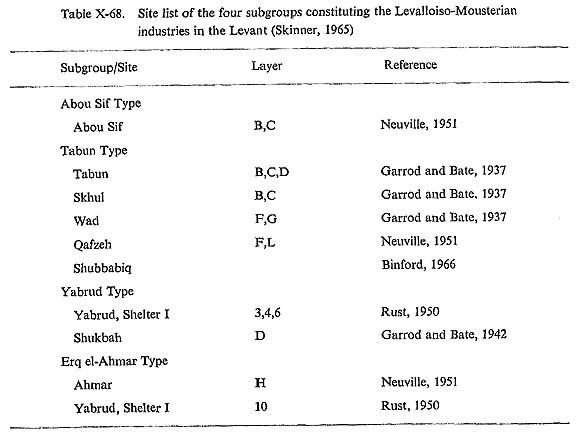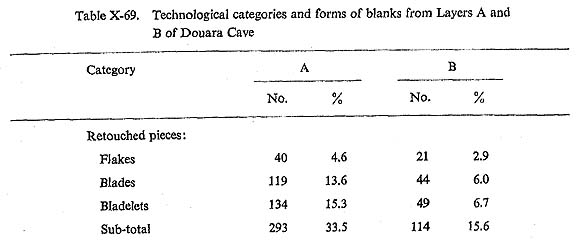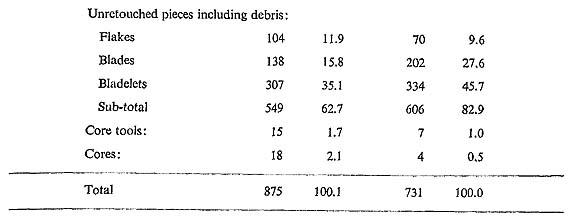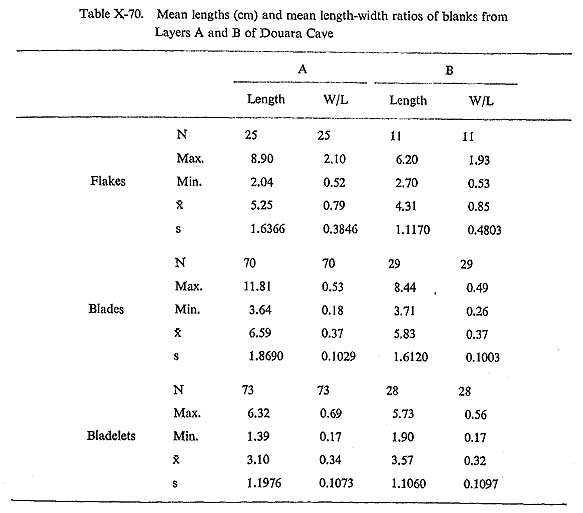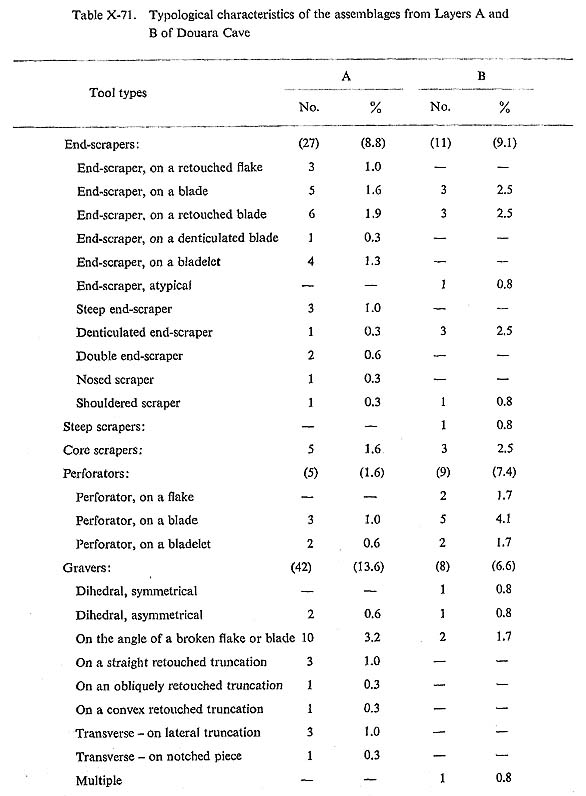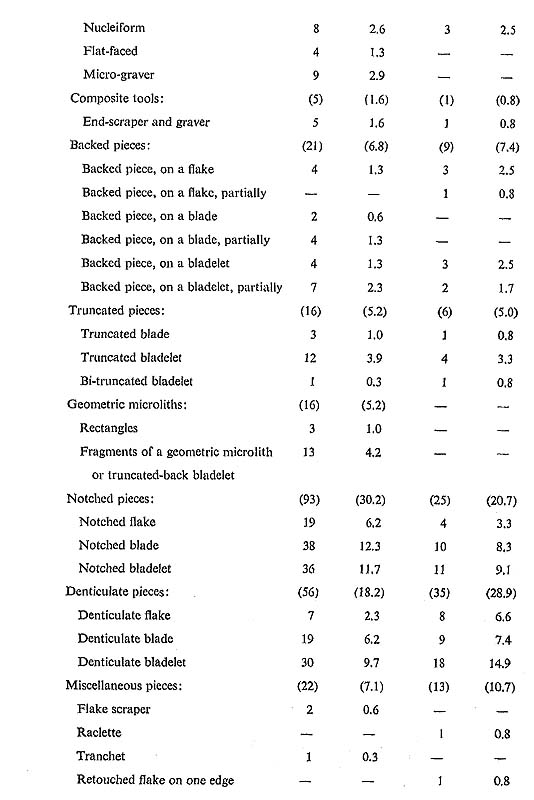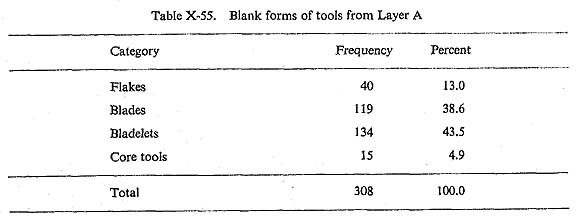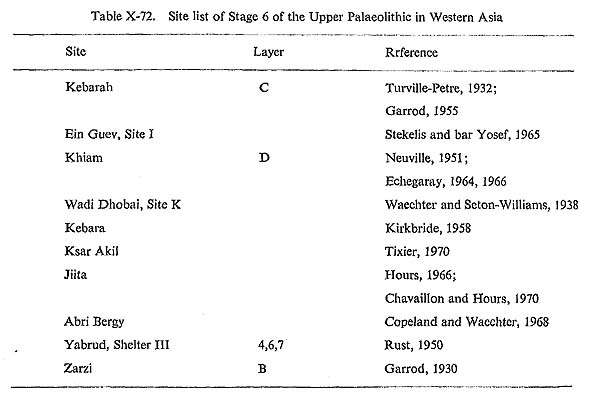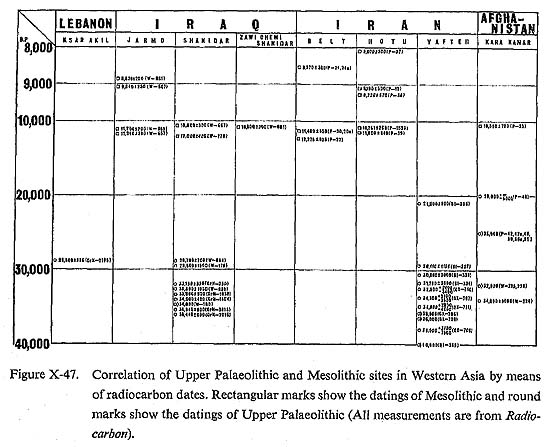CHAPTER X
PALAEOLITHIC ASSEMBLAGES FROM THE DOUARA CAVE SITE
Takeru AKAZAWA
Department of Anthropology and Prehistory, The University Museum, The University of Tokyo
| ( 5 / 7 ) |
3. FURTHER DISCUSSION ON THE PALAEOLITHIC ASSEMBLAGES FROM THE DOUARA CAVEIn the preceding discussion it was seen that the deposits of Douara Cave contain two distinct assemblages: an assemblage with a large proportion of Levallois flakes found in Layers C, D and E, and an assemblage with a large proportion of blade and bladelet elements of Upper Palaeolithic character found in Layers A and B. The next problem is to determine the relationships of these assemblages to those from relevant sites elsewhere and to provide new data for making a framework to which future work on the Palaeolithic can be related. But first, to establish a base for this comparison, it is necessary to compare Douara's lithic assemblages with each other, that is, to compare the assemblages from Layers C, D and E to each other, and to compare the assemblages from Layers A and B to each other. However, the excavated area in most layers is small and there are considerable differences in the volume of the deposits in each layer (Figs. X-1, 2). Therefore, any conclusions are tentative and many questions remain unsolved. These can be confirmed or clarified only by further excavation of the cave. Both the intra site and the inter site comparisons are based on the technological and typological characteristics of the assemblages (as described in the preceding section) and move from the lower to the upper layers.
1) Assemblages of Layers C, D and EINTRA SITE COMPARISONTECHNOLOGICAL COMPARISONBlanksThere are four technological classes of the tool blanks found in Layers C, D and E of the Douara Cave-Levallois, non-Levallois, core and core rejuvenation flake-and the proportion of these classes are about the same in each layer (Table X-61).
The most striking feature of each assemblage in Layers C, D and E is the dominant role played by the Levallois technique in the production of tool blanks-the Levallois Index is 77.7 in Layer E, 74.9 in Layer D and 72.2 in Layer C (Table X-62). There is a slight decline in the value from the bottom to the top layer, but the difference is not significant. Therefore, the assemblages from Layers C, D and E of Douara Cave are technologically characterized by the Levallois technique in blank production.
However, the relative proportion of the three types of Levallois blanks-flakes, blades and points-varies somewhat in each layer. Especially, the frequency of Levallois blade blanks exceeds that of Levallois flake blanks in Layer E, but the reverse is true in Layers C and E. And over 50 percent of the Levallois tools in Layer E are on blades, while only approximately 30 percent of the Levallois tools are on blades in Layers C and D. In contrast with the extremely high value for the Levallois technique used in the production of tool blanks, the proportion of non-Levallois blanks upon which tools are made, is, as a matter of course, extremely low in Layers C, D and E (Table X-61). These non-Levallois blanks consist of flakes and blades, naturally backed flakes and blades, and micro-butt blades. The proportion of each non-Levallois blank in these layers is about the same for each layer, and the only significant distinction among these assemblages is that the quantity of naturally backed flakes and blades rises from Layer E through Layers D and C and the frequency of the naturally backed flake and blade blanks is less than that of other non-Levallois blanks in Layer E. Three kinds of prepared striking platforms were observed at the proximal ends of blanks -faceted, dihedral faceted and smooth. The Faceting Index is highest in Layer D at 81.5, and declines to 74.8 in Layer E and to 70.9 in Layer C. The Faceting Index in the strict sense shows the same tendency. Though there is a slight difference in the value from bottom to top, the difference is not significant, and it seems that these assemblages are markedly characterized by the extremely high value for the faceting technique used in the blank removal. The micro-butt, which is in sharp contrast to the other butt forms, is extremely low in frequency in all three layers. On the other hand, the relative quantity of blades (elongated flakes whose length is greater than twice their width) is under 50 percent in all three layers. Its value is only moderately high at 47.7 (Blade Index) in the assemblage from Layer E but drops to 34.3 and 30.2 in Layers D and C (Table X-62), which reflects a strong tendency seen in Layer E for production of elongated blanks. This tendency in Layer E corresponds to the proportion of Levallois blade blanks which exceeds the proportion of Levallois flake blanks only in Layer E. To examine the flake-blade proportion in the assemblages from Layers C, D and E, we compared the distribution of the lengths and the length-width ratios of blanks in these layers. The distribution of the lengths of blanks is nearly the same in both Layers D and E, and the mean length of the blanks shows a slight decline in value from bottom to top (Table X-63). On the other hand, the length-width ratios, showing the narrowness of blanks, are similar in all three layers but the values rise slightly from bottom to top (Table X-63). These distributions reflect the fact that the morphological features of the blanks in all these layers are nearly the same but the blanks become slightly broader from bottom to top.
To summarize, the separate assemblages in Layers C, D and E of the Douara Cave are markedly characterized by a dominance of the Levallois technique and the platform preparation technique in the production of blanks. On the other hand, the relative quantities of the classes of blank forms are slightly different in each layer. Foremost among them, the relative quantity of blade blanks is significantly higher in Layer E than in Layers C and D, and this is most noticeable among the Levallois tools. Also, the values of the lengths and the length width ratios of blanks reflect the tendency seen in Layer E for the production of large, elongated blanks. CoresSixty one cores were found in Layers C, D and E (Table X-64). All these belong to types set forth by Bordes (1961: 71-73). Levallois type cores (27) are the most common type, and cores of the discoidal type (12) and the prismatic type (7) are moderately popular at Douara Cave. The prismatic type are found only in Layers D and E, but the Levallois and discoidal types are found in all three layers.
The Levallois cores are the most abundant in all three layers (Table X-64). About 50 percent of the cores belongs to Levallois category in each layer. These Levallois cores fall into three forms following from the type of blank intended-flake, blade and point types. The forms of the Levallois cores in each layer are markedly different. A large number of the Levallois cores in Layers C and D are characterized by a single broad flake or point-shaped flaking scar on their main surface (Figs. X-13, Nos. 1-3, 7; X-14, No. 1; X-15, No. 1; X-27, No. 4). They are roughly rectangular to oval in outline, with uni-directional scars on their flaking surfaces. In cross-section they are generally tortoise-shaped. On the other hand, a large number of the Levallois cores in Layer E have several elongated, parallel flaking scars running uni-directionally or bi-directionally on the main flaking surface (Figs. X-4, Nos. 1, 4; X-5, No. 2; X-6, No. 2), while only two of the Levallois cores in that layer have broad bi-directional flaking scars on the main flaking surface (Fig. X-5, No. 1).
These differences of the Levallois core types in Layer E and Layers C and D possibly correspond to the differences in the relative quantities of blade blanks in Layer E and in Layers C and D-as already discussed, the relative quantity of elongated blade blanks is significantly higher in Layer E than in Layers C and D. Moreover, these differences are also related to the fact that over 50 percent of the Levallois tools in Layer E are on blades, while only approximately 30 percent of the Levallois tools are on blades in Layers C and D. In addition to the points mentioned above, the fact that the length-width ratios of blanks show a lower value in Layer E than in Layers C and D means that in Layer E there observed a tendency for the production of elongated blade blanks. And it is possible that a large number of these blade blanks in Layer E were removed from the Levallois cores with several elongated flaking scars. These cores are most abundant. As with the Levallois cores, the quantities of discoidal and prismatic cores vary between Layer E and the succeeding layers (Table X-64). Discoidal cores are abundant in the upper Layers C and D, and prismatic cores are most abundant in Layer E. The discoidal cores include both a tortoise-shaped type and a flat type. In both cases, these cores are elaborately prepared and are characterized by a number of broad, oval flake scars arranged centripetally along the perimeter of cores suggesting removal of flakes rather than blades (Figs. X-5, Nos. 4, 5; X-14, No. 3; X-15, Nos. 3, 4; X-27, Nos. 3, 5). The prismatic cores are characterized by a generally prismatic form, cortex on their reverse surface, a series of parallel, uni-directional flaking scars showing a number of removals from a single plane platform, and a flaking surface that extends around the piece rather than being a single flat surface as on the Levallois cores (Figs. X-4, Nos. 2, 3; X-5, Nos. 3, 6; X-6, Nos. 1, 5;X-15, No. 2). A number of uni-directionally flaking scars on their main surfaces are generally characterized by elongated forms, suggesting removal of blade blanks rather than flakes. The forms of the flake scars of these discoidal and prismatic cores also suggest a relation ship with the relative quantities of blade blanks in Layers C, D and E, as already discribed. It is possible that core size corresponds to blank size. The mean length of flaking scars on cores is greatest in Layer E, declining in Layers D and C (Table X-63). The mean length of blanks is also greatest in Layer E, as already mentioned. This suggests a positive relation ship between core size and blank size. However, there is a gap of 1-3 cm between blank size and core flake scar size in all three layers. One possible explanation of this gap is that the cores are continuously reworked until they became reduced in size and are abandoned (Schroeder, 1969: 375-376). TYPOLOGICAL COMPARISONThe assemblages in these three layers can be characterized according to three kinds of typological data (Tables, X-62, 65): 1) the quantities in the major typological groups, Levallois Tools (I), Mousterian Tools (II), Upper Palaeolithic Tools (III), and Denticulate Tools (IV), 2) the quantities in the specific tool classes, Levallois Tools (ILty), Side-scrapers (IR) and Backed Knives (IAu), and 3) the quantities of specific tool types classified according to Bordes' (1961) list.
All the flint artifacts from Layers C, D and E are classified by the typological system set forth by Bordes (Bordes, 1961). The most striking feature of each assemblage is that the largest category of tools is Levallois (I or ILty)-the Index of Levallois Tools is 57.9 in Layer E, 59.4 in Layer D and 55.0 in Layer C (Table X. 62). There is a slight variation in the value in each layer, but the difference is not significant. The typological characteristics of the assemblages of these layers show about the same values for the relative proportion of Levallois tools in each tool assemblage. In making the comparison of the three layers according to other typological data, the assemblages in Layers C, D and E are seen to have extremely low frequencies of Mousterian type (II and IR), Upper Palaeolithic type (III and IAu) and Denticulate type (IV) tools, and the values for the three layers are seen to resemble each other very closely (Table X-62). On the other hand, the diversity of tools classifiable with reference to Bordes' (1961) standard type list varies slightly among layers-21 types in Layer E, 24 types in Layer D and 17 types in Layer C (Table X-65). The diversity of tools classifiable with reference to Bordes' typology as subdivided by Sonneville-Bordes and Perrot (1954-1956) and Schroeder (1969) also varies among layers-32 types in Layer E, 34 types in Layer D and 23 types in Layer C. According to either system, Layers D and E contain the greatest variety of tools type, and Layer C contains the least. The most marked distinction between layers in terms of specific tool types is the especially large variability of side-scrapers and gravers in Layer D. The relative quantities of these tools to the assemblages show about the same tendencies, and the Index of Side-scrapers has almost the same value in all three layers. Another distinction among these assemblages is that the proportion of naturally backed knives differs Significantly, rising from Layer E through Layers D and C. Especially, this category is the second most prominent tool type in Layers C and D, next only to the Levallois type tools. These tools are generally characterized by the presence of a naturally blunt edge along one margin of a flake or blade, and a naturally sharp cutting edge along the other margin which also has extensive traces of secondary use (Figs. X-11, Nos. 9-11; X-24, Nos. 1-9; X-25, Nos. 1, 2). Although it is probable that this category was originally waste flakes or blades produced in the preparation of the Levallois and prismatic type cores, the traces of secondary use observed on the margin suggest that they were later used as tools.
If compared according to these three categories of typological data, the assemblages in Layers C, D and E are seen to generally resemble each other except for some differences in the diversity of tools. But it is not certain if these similarlities and differences are representative of the true nature of the assemblages because deposits of each layer are markedly different. SUMMARYThe assemnlages of Layers C, D and E, of the Douara Cave, are generally characterized by having the technological characteristic of an extremely high frequency of the Levallois technique in the production of blanks and the typological characteristic of a large number of Levallois type tools (I). However, broad technological and typological comparison of the assemblages in Layer C, D and E, shows a number of differences among these three layers. Technologically, the blank forms and the core types in these three layers do manifest slight but significant differences. The assemblage in Layer E reflects a tendency for the production of elongated blade blanks, while the assemblages in Layers D and C reflect a tendency for the production of broad flake blanks. In comparing the relative proportion of the core type of each layer, Layer E contains the large quantity of prismatic type cores, while the majority of cores in the succeeding layers belongs to the Levallois category. Typologically, each typological group and index has almost the same value in all three layers, but the diversity of tools classifiable with reference to Bordes' (1961) type list varies among layers. The marked distinction among the assemblages of these three layers is that the side-scrapers and gravers of Layer D show more variability than those of the other layers. Another distinction among these assemblages is that the relative proportion of naturally backed knives differs significantly, rising from Layer E through Layers D and C. Finally, the significance of these differences is not certain because the flint artifacts were obtained by a small preliminary excavation and the sample might not be representative. A valid comparison of these assemblages is not possible now but will be attempted in the future. INTER SITE COMPARISONThe assemblages of Layers C, D and E of the Douara Cave are characterized by an extremely high value for the Levallois technique in blank production and a large number of Levallois tools. These assemblages have been well-defined both technologically and typologically as belonging to the Middle Palaeolithic of Western Asia. The Middle Palaeolithic industries in Western Asia have a high degree of variability both technologically and typologically. The next task is to compare the industry from the Douara Cave to the established sequence of Middle Palaeolithic industries. In making such a comparative study, it is necessary that all data showing the technological and typological charac teristics of relevant sites are described in the same manner, for example, that they are described according to Bordes' (1961) classification system, and Bordes and Bourgon's (1951) technolo gical and typological indices, and that they include the total collection from each site. Skinner (1965) has compared the Middle Palaeolithic industries of Western Asia. on the basis of Bordes' classification system and indices. As a result, he divided the Middle Palaeolithic assemblages in Western Asia into three groups (Skinner, 1965 : 134-189). Group A is the Middle Palaeolithic industry found in the Zagros Mountains. This industry is characterized by the negligible use of the Levallois technique in the removal of blanks, the common use of faceted striking platforms, a very high percentage of Mousterian type tools such as Mousterian points and side-scrapers, and the extensive use of retouch to modify the blanks into toots. Group B is the Middle Palaeolithic industry identified as the Yabrudian Industry and found in the restricted area of Levant. This industry is characterized by the absence of the Levallois technique, the rare use of striking platform preparation, a very high per- centage of side-scrapers, and the extensive use of retouch in making tools. Group C is the well- known Middle Palaeolithic industry found over a wide area of Western Asia. This is the industry known as the Levalloiso-Mousterian or Mousterian of Levallois facies. It is generally characterized by the moderate to common presence of faceted striking platforms, a low per- centage of side-scrapers, and the common use of unretouched Levallois type tools. Table X-66 lists the major sites representing each group described by Skinner (1965).
Each of these Middle Palaeolithic industries in Western Asia is distinct from the others in time and in space (Skinner, 1965 : 190). The Zagros Mousterian is found only in a restricted area centered on the Zagros Mountains and does not extend west of the Tigris River. Both the Yabrudian and the Levalloiso-Mousterian occur in the Levant, although Yabrudian has been found at only six sites and in a more restricted area than the Levalloiso-Mousterian. However, the temporal relationship of these latter two industries is clear from the stratified deposits of three sites yielding both industries. The sites of Yabrud (Rust, 1950), Tabun (Garrod and Bate, 1937), and Bezez (Garrod, 1966) contained two industrial assemblages, one Yabrudian and the other Levalloiso-Mousterian. In all three sites, the Yabrudian was always the earlier industry. The Middle Palaeolithic assemblages in the Douara Cave Layers C, D and E are closely allied, typologically and temporally with the Levalloiso-Mousterian Industry represented by the Group C sites (Table X-67. Figure X-46 is a seriation diagram showing the relative values of the typological and technological indices calculated for the assemblages representing each major group of sites. This diagram shows clearly the close relationship of the Douara assemblages to the Levalloiso-Mousterian Industry. Each is characterized by a common use of the Levallois technique for the removal of blanks (IL), a common use of faceted striking platforms (IF), a common use of unretouched Levallois type tools (ILty), a very low percentage of Mousterian type tools such as side-scrapers (IR), and an absence of Quina type retouch in the making of tools (IQ).
The Levalloiso-Mousterian was first recorded as a separated component of the Middle Palaeolithic sequence in Western Asia at the Tabun Site excavated by Garrod (Garrod and Bate, 1937). Since then, dozens of assemblages having the same characteristic features have been found, and these assemblages usually have been reported under the single nomenclature of Levalloiso-Mousterian or Mousterian of Levallois facies. However, Skinner (1965 : 149- 164) pointed out the possibility that the Levalloiso-Mousterian industries of the Levant exhibited a greater typological and technological variability than either of the other two industries. He divided the Levalloiso-Mousterian industries of the Levant into four subgroups: Abou Sif type, Tabun type, Yabrud type and Erq el-Ahmar type (Table X-68).
In comparing the Douara assemblages with other Levalloiso-Mousterian assemblages (Table X-67), they are seen not to match wholly with any of Skinner's four subgroups of the Levalloiso-Mousterian industry. For example, technologically the Douara assemblages closely resemble those of Abou Sif and Jerf Ajla, each having a high use of the Levallois technique (IL), a high use of faceted striking platforms (IF) and a relatively moderate use of blade blanks (ILam). However, the proportion of blade blanks in Douara Layer E is moderately high in comparison with that of the other assemblages. Typologically the Douara assemblages are clearly distinct from those of Abou Sif in the extremely low use of Mousterian type tools in the Douara assemblage. But in this characteristic they compare well to the assemblages of Ahmar, Jerf Ajla Units C and E, Shukbah, Yabrud Shelter I Layers 3 and 10 and Wad which are, however, distinct from the Douara assemblages in their extremely high percentage (over 70 percent) of unretouched Levallois type tools. Of all the assemblages for which data are available, Douara's assemblages have the greatest similarity to Jerf Ajla Unit B. Nevertheless, it is difflcult to establish with certainty a close relationship between Douara's assemblages and any assemblage from another site because the Douara excavation was limited. The above interpretations must be viewed as tentative. 2) Assemblages of Layers A and BINTRA SITE COMPARISONThe assemblages from Layers A and B show a unique relationship having a number of similarities as well as differences. Technologically, there are a number of similarities between Layers A and B. The frequencies of different blank forms vary little between layers (Table X-69), and the sizes of the blanks vary only slightly (Table X-70). The flint in both layers is patinated a brown color and varying amounts of calcareous concretions adhere to the surfaces of a large quantity of the pieces.
Typologically, the assemblages from Layers A and B are markedly different one another (Table X-71). The total number of tools is 308 in Layer A and 121 in Layer B, and the propor tion of tools to total flint artifacts is 35.2 percent in Layer A but only 16.6 percent in Layer B. Moreover, the number of different tool types is 47 in Layer A but only 33 in Layer B, and the compositions of both assemblages are markedly different from one another.
Along with these similarities and differences in the two assemblages, consideration should also be given to the deposits from which they come: Layers A and B lie in a unique basinshaped depression and it is questionable whether the deposits are primary. Moreover, the quantity of flint artifacts in Layer B is relatively large in comparison with the valume of the deposits. It is probable that these two assemblages show accidental mixture. A valid comparison of the two assemblages presently is not possible but will be attempted in the future. For the reasons described above, it is questionable to try to establish the cultural relationship of these two assemblages found in the 1970 season. Therefore, at this time, I will only give the general characteristics of the assemblages, mainly that from Layer A, to provide new data for making a framework to which future work on the Douara Cave can be related. Technologically, the most striking feature of the assemblage from Layer A is the large pro- portion of tools made on blade and bladelet blanks-13.0 percent are flakes, 38.6 percent are blades and 43.5 percent are bladelets (Table X-55)-usually produced by the punch technique. This characteristic feature is also observed in the relative quantity of these three blanks to total flint artifacts from Layer A (Table X-69). The major core type in Layer A is the prismatic category, subclassifled as uni-directional or bi-directional according to the direction of the main flaking scars. The flaking scars on the main surfaces are all very small and narrow, suggesting these were used to produce the blades and bladelets seen in large quantity among the blanks in this layer. Typologically, the assemblage of Layer A is markedly characterized by microlithic tools such as micro-gravers, geometrics, and backed and truncated pieces made on bladelets, as well as various types of scrapers and gravers on blades (Table X-71). Especially, the most striking feature of the assemblage is that microlithic type tools constitute about 50 percent of the total tools (Table X-55).
INTER SITE COMPARISONThe most striking features of the assemblages from Douara Layers A and B are 1) the large proportion of tools made on blade or bladelet blanks usually produced by the punch technique and 2) the importance in the assemblages of microlithic tools such as micro-gravers, geometrics, and backed and truncated bladelets, as well as various scrapers and gravers on blade blanks. The assemblages characterized by these features have been well-defined both technologically and typologically as belonging to the Upper Palaeolithic in Western Asia. The sequence of Upper Palaeolithic industries in Western Asia was first established by,Neuville (1934, 1951) on the basis of the data from a number of stratified sites. Neuville postulated a sixfold division of the Upper Palaeolithic in Western Asia. Although Neuville's nomenclature is not wholly acceptable to explain the sequence of Upper Palaeolithic industries in Western Asia, it subsequently was followed by Howell (1959) and has been applied widely to sites in Western Asia. Consequently, for convenience Neuville's nomenclature will be used to compare Douara's Upper Palaeolithic assemblages with those from other sites. Upper Palaeolithic assemblages showing the same characteristics as those of Douara Layers A and B correspond to Stage 6 in Neuville's nomenclature. Stage 6 industries are now welldefined in Western Asia, both typologically and stratigraphically (Copeland, 1968). Generally speaking, the most striking features of Stage 6 assemblages are their mixture of characteristics of the preceding Upper Palaeolithic industries and characteristics of the succeeding Mesolithic industries. The Upper Palaeolithic characteristics are 1) a large quantity of blade blanks usually produced by the punch technique and 2) various scrapers and gravers and backed knives on blades as the dominant tool types. The Mesolithic characteristics are 1) a large quantity of bladelet blanks and 2) an abundance of microlithic tools such as those of the Natufian industry. Stage 6 assemblages differ from other Upper Palaeolithic industries in their relatively low quantity of steep scrapers and polyhedric gravers. Table X-72 lists the sites representing Stage 6 of the Upper Palaeolithic in Westen Asia.
Of these sites, Kebarah and Yabrud are very important. Kebarah is the type site of this stage. The assemblage from Layer C of that site was identified as belonging to Stage 6 of the Upper Palaeolithic and designated the Kebaran industry by Garrod (Garrod, 1937, Garrod and Bate, 1937). Layer C has a Mesolithic appearance and is immediately below the Lower Natufian level and above a series of three levels with Stages 3 and 4 of the Middle Aurignacian (Turville-Petre, 1932). Microlithic tools predominate over normal-sized blade implements, and the characteristic microlithic form is a much elongated triangle retouched along the back and at the tip. Other forms are straight points and small curved points. The normal-sized blade implements are not characteristic and include end-scrapers, a few steep and semi-steep scrapers, and a few gravers of prismatic and bec-de flute types. Layers 7, 6 and 4 of Shelter III of the Yabrud Site produced Nebekian industries as designated by Rust (1950), and these correspond to Stage 6 of the Upper Palaeolithic in Western Asia. Relatively small collections were obtained from Layers 4 (241) and 6 (167). A larger collection was obtained from Layer 7 (1061). The assemblage from Layer 7 is characterized by microlithic tools in considerable abundance (25 percent of the complete tools and cores). The forms of these microliths show strong similarities with those of the Kebaran industry from Kebarah: one form is an elongated triangle retouched along the back and at the top and other forms are straight and slightly curved points, with numerous micro-gravers making up about 5 percent of the total microliths. On the other hand, larger tools on normal-sized blade blanks are not frequent and consist of twelve gravers and thirteen steep scrapers. Another facies of microlithic industry showing a Mesolithic appearance was found in Layer B of the Zarzi Cave to the east in the Zagros foothills of southern Kurdistan. This site is the type site for the Zarzian industry (Garrod, 1930). This assemblage has numerous microlithic tools such as slightly curved backed bladelets (21), geometric triangles (36), microscrapers (79), microgravers (3), and unclassified fragmental pieces (17). The relative quantity of these microliths is about 25 percent of the total tools. On the other hand, the tools on normal-sized blade blanks largely consist of notched and/or denticulated pieces (190), and various scrapers including end-scrapers (225), while gravers (28) are few. These Stage 6 assemblages from Kebarah, Yabrud and Zarai are generally characterized by the predominance of microlithic tools and a decrease in the steep scrapers and gravers on normal-sized blade blanks that characterize the preceding Upper Palaeolithic stages. These characteristics are also recognized in the assemblages from Layers A and B of the Douara Cave. No radiocarbon dates have been obtained from Douara Layers A and B. However, for a number of sites in Western Asia corresponding both typologically and stratigraphically to the terminal Upper Palaeolithic or to the Mesolithic stage, radiocarbon dates have been obtained (Fig. X-47).
Shanidar Cave, northwest of the Zarzi site, has a microlithic industry in Layer B. This assemblage, overlaying the considerably earlier Upper Palaeolithic industry (Baradostian industry) of Layer C, shows the same features as Stage 6 assemblages of the Upper Palaeolithic in Western Asia (Solecki, 1952, 1955). A radiocarbon determination of 12,000 ±400 years (W-179) has been made for Layer B (Rubin and Suess, 1955). This provides for the first estimation of an absolute age for a terminal Upper Palaeolithic industry of the microlithic type in Western Asia. Moreover, assemblages belonging to a slightly younger stage than that from Layer B of Shanidar (Howell, 1959 : 33) were found in Jarmo (Braidwood and Howe, 1960), Zawi Chemi Shanidar (Solecki, 1964), Hotu and Belt Caves (Coon, 1951, Coon and others, 1952) and Kara Kamar (Coon and others, 1951, Coon and Ralph, 1955). These are generally characterized by the microlithic horizons of the Mesolithic stage in these areas and they have radiocarbon ages of approximately 10,000 to 12,000 years. On the other hand, the Baradostian industries from Layer C of Shanidar (Solecki, 1952, 1953, 1955a, b) and Yafteh in Iran (Hole and Flannery, 1967), the Aurignacian type industry from Ksar Akil (Ewing, 1947) and the Upper Palaeolithic horizons of Kara Kamar (Coon and others, 1951) are characterized by typical Upper Palaeolithic assemblages without microliths and belong to Stages 2 to 3 (Howell, 1959 : 28-30). The radiocarbon determinations of these horizons are largely over 20,000 years. These age determinations support the relative dating of Stage 6 to about the time of the final stadial of the Last Pluvial and the onset of the subsequent Post-Pluvial. Knowledge of the Upper Palaeolithic in Western Asia has increased greatly in recent years largely as a result of excavations of relevant sites and also as a result of restudy of certain site and museum collections such as el-Khiam (Echegary, 1964, 1966), Abri Bergy (Copeland and Waechter, 1968). (See also Howell, 1959, for a general review of these two sites and other sites in the Levant.). But a number of problems remain unsolved. For example, the problem of the succession of the Upper Palaeolithic Stages and the problem of European-West Asian cultural relationships. Moreover, the deposits of Douara Layers A and B, found in the 1970 season, show remarkable uniqueness, but it is questionable whether their assemblages are representative. Therefore, further discussion of the inter site comparisons of the assemblages of Douara's Upper Palaeolithic will not be attempted here. |

